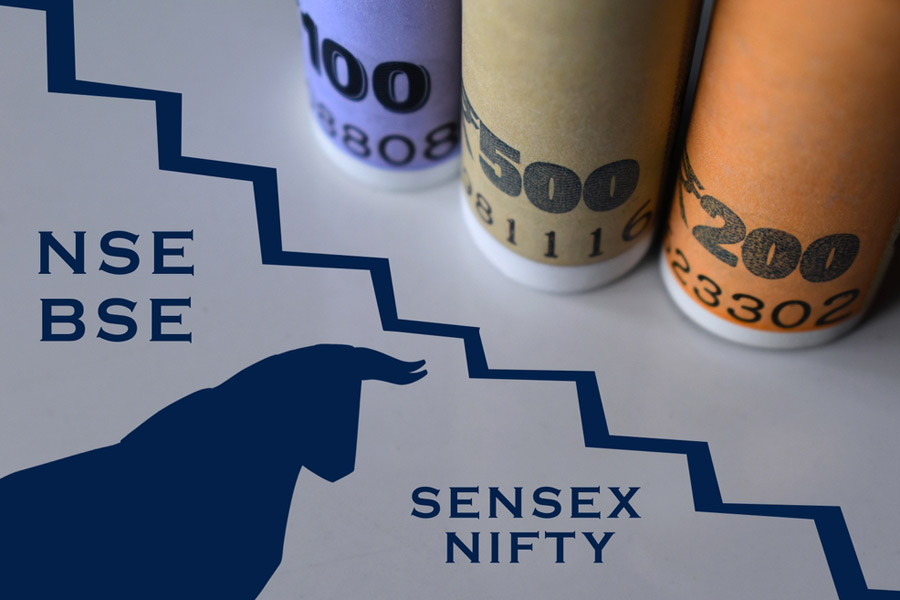 |
| Marc Riboud’s photograph of the Mao statue; (below) a photograph by Karam Puri |
 |
Marc Riboud will be honoured with a lifetime achievement prize at the Sony World Photography Awards next month at Cannes. A small exhibition of black-and-white prints from this 85-year-old photographer’s prodigious body of work is being exhibited at the Seagull Art and Media Resource Centre.
Widely travelled, some of his photographs from the 1950s taken in China and Afghanistan are auguries of their troubled futures. Clouds of smoke billowing from two chimneys seem to have the blessings of Chairman Mao, whose giant statue dominates the horizon. In Afghanistan, a young boy holds a shining pistol to his head, years before the USSR had invaded the country, and the supply of American weaponry to the insurgents led to the formation of the Taliban.
But Shanghai in 2002 has turned into a haunting futuristic city straight out of Bladerunner. Riboud captures moments of lyrical beauty in the Chinese province of Huang Shan with its towering mountains wreathed in mists, image immersion in the Hooghly and Iranian children on a dirt road.
He documents the Bangladesh war, the poverty in Nepal, street scenes in Maoist China and the “peacenik”, who confronts bayonet-wielding troops with a flower, with equal objectivity. The “Bihari” family in Bangladesh is obviously in sorrow but Riboud maintains his distance.
His most famous image is that of the man painting the Eiffel Tower with the ease of Gene Kelly dancing in the rain. It is smart and captures the worker in a triangle of girders. One image in this show is rather baffling. How does one react to an image of a little boy and girl climbing into their undergarments?
Karam Puri is a young photographer who was born in India and has lived in cities all over the world. His photographs being exhibited at CC&FC till Sunday are proof enough of Puri’s itinerant life. He uses both digital and analogue technology to take photographs in exotic locales. Africa, China, Japan, Gujarat and Rajasthan are some of the spots he visited to record landscapes in lush hues that one could easily mistake for stills from early Technicolor films.
His best colour photographs are some smart shots of women celebrating the cherry blossom festival in Japan, the streak of light in a railway station and his black-and-white prints for which he used 3200 ASA Agfa film. This accounts for the grainy effect that gives some of them a poetic look.
One of his best images titled Bryant shows two balls held in the palms of a man, fingernails pared to the quick. The play of light on glossy leather conveys the solidity of the balls. The cherry blossom photographs with the row of fan-like headdresses and calligraphy on the bare backs of “geishas” stand out for the delicacy of their colouring and clean structure.
The beauty of colouring in some of the prints is enhanced by the archival paper he uses, although that does not save his landscapes that look like scene painters had had a go at them.
Puri says he used high-definition range photography to shoot his images of a famous temple with rain clouds racing behind them, and the same technique to photograph the tomb of Humayun. While the desolate mausoleum looks dignified with its play of light and shadow, in the temple shot, the sky looks like an afterthought.
Mon Art Gallerie’s exhibition, God Icons Masses, is, as the title suggests, a shot at popular media, adverts and the gods they create. Most of the works like the media they spoof are engrossing and eye-catching, and, what’s more, are leavened with humour.
Snehashish Maity packages himself like a pouting jack-in-the-box ever ready to oblige. Satyajit Das’s Krishna with paparazzi is an interesting concept in an age when nothing is sacred. Debanjan Roy’s bright red Father of the Nation is also interesting for the same reason, or unreason, as one may chose to interpret it.
Visually, Jyotirmoy De’s vegetable patch pullulating with critters is the most arresting. The only sculptural pieces are by Lal Kishor Pradhan from Orissa. Irrespective of the stories he is trying to tell, what viewers may find more interesting is the enigmatic quality of the watch with the prosthetic limbs on the band, and clock with a hand for a pendulum.
One wonders why Anant Art gallery alternates exhibitions of the poorest quality with well-curated shows. The current exhibition of the paintings of Sandip Daptari is of the former variety. His works are a sentimental mishmash about childhood and its associations with innocence. The artist from Baroda has tried to sex it up by presenting his works in different formats. But this does not rescue these ill-conceived paintings.










